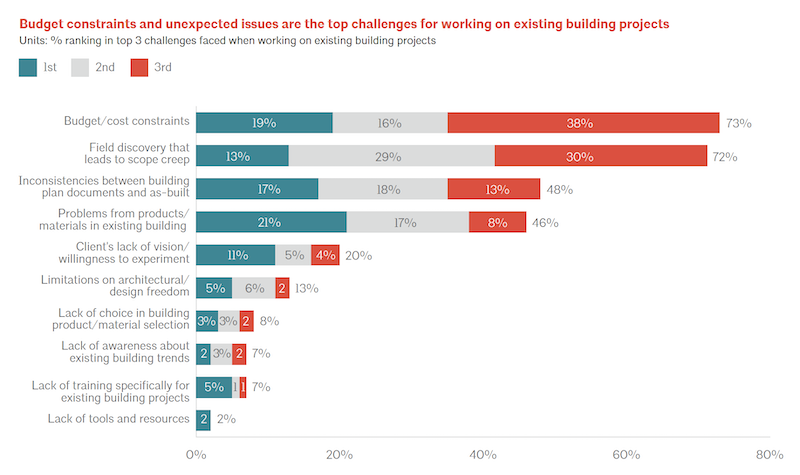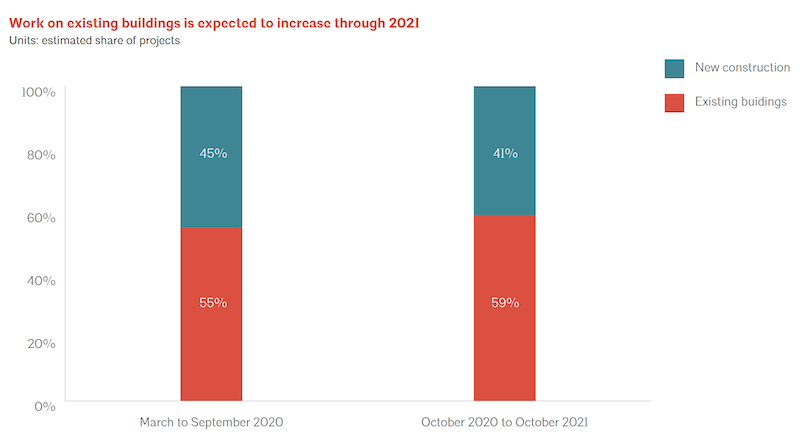The coronavirus pandemic accelerated a shift toward architectural design work on existing buildings that already had been underway. That shift presents new opportunities, but also challenges that manufacturers and other partners can help architects meet. But when it comes to designing sustainably, architects need to become more than just “passive advisors” who leave final decisions to clients.
These are some of the key findings from a new 43-page report, “Business Opportunities & Sustainability Trends Amidst a Pandemic,” that has been published by the American Institute of Architects (AIA) in partnership with Oldcastle Building Technology. The report is based on responses from 229 architecture firms that completed a survey that was in the field from October 20 through November 17, 2020.

The largest number of respondents was affected by the recession only moderately.
The study found 2020 to be “a tale of two markets,” with declining demand in most nonresidential sectors and increasing demand in residential sectors, especially single family. From March to September 2020, surveyed respondents reported an increase of 34% for single-family work and 12% for multifamily; and a net decrease in work in the nonresidential sectors including retail (down 49%), offices (-35%) and Higher Ed (-29%).

Demand for residential design was the one silver lining of last year's COVID-19 outbreak. And the nonres sectors that took it on the chin are likely to see most of their new work in existing buildings in 2021.

According to the AIA Consensus Construction Forecast released in January 2021, nonresidential building spending is expected to continue to decrease with a forecasted decline of 5.7% in 2021. Out of nonresidential building spending, the commercial sector is expected to continue to decline the most in 2021, by 7.1%, compared with 4% for the institutional sector.
Healthcare, higher education, and K–12 education are expected to have the greatest opportunities for growth in existing buildings in 2021, whereas there are declines expected in new building projects.
EXTERNAL COMMUNICATION WAS TOUGH DURING PANDEMIC

The pandemic's impact on client relationships was relatively minor. But budgeting was cited as the biggest challenge for architects working on existing buildings.

The two biggest challenges architectural professionals reported facing with existing buildings were budget/cost constraints (73% of responses) and field discovery that leads to scope creep (72%). Further, nearly half (48%) of those surveyed reported the challenges of inconsistencies between building plan documents and as-built, and problems from products/materials in existing buildings (46%).
Many firms shifted into a virtual work environment during the pandemic, and found it difficult to maintain productivity. Of the 71% of architects who reported negative impacts on construction, some of the reasons given were delayed timelines, price increases for materials or limited materials, lack of workers, COVID-19 restrictions, and difficulties with external communications.
A little over one quarter (26%) reported the pandemic negatively impacted their relationships with clients. The primary reason for that was also communication (reported by 63%, the top reason) but closely followed by more worsened collaboration. Difficult communications were also cited as the main reason for any negative impact on supplier relationships.
On the positive side, design quality was the only business aspect that showed no notable impact from the pandemic—with a vast majority (77%) reporting no impact. Other respondents were encouraged by technology, focus on design, and less distraction.
SUSTAINABILITY DEMAND CONTINUES TO EXPAND

Not surprisingly, Higher Ed is deemed by architects as being the nonres sector where sustainability innovation flourishes. The study found, though, that a sizable number of architects are still on the sidelines when it comes to moving clients toward sustainable project goals.

Architects were hopeful about their opportunities from sustainable design, especially in housing and healthcare projects. The majority of those surveyed reported that clients increasingly are willing to invest in design that leads to better occupant health and productivity (78%) and are willing to pay for design and materials that reduce disease transmission (61%). Additionally, 63% of respondents reported that sustainability concerns increasingly are important when specifying building products/materials and that they are seeing consultants increasingly focused on sustainability.
Across nearly all these measures, significantly higher shares of respondents from the largest firms (500 or more employees, which comprise a substantial share of architectural billings) reported client interest in sustainability.
By way of example, the report quotes a commercial owner in the Southeast who says that sustainability and wellness are “core principles for the group, and climate change is a fundamental consideration. Looking forward, our future projects will have similar sensitivity to the impacts of climate change.”
Even after the pandemic is controlled, data and history suggest that this concern will remain strong, given both owners’ desire to mitigate future risk and the historical strength of improved health outcomes as a driver to green building and sustainable design. Sixty-three percent of respondents also said sustainability is increasingly important in specification of building products and materials.
ARCHITECTS MUST LEAD THE CHARGE TOWARD SUSTAINBILITY

Construction, planning and project management were impacted by the pandemic's restrictions on physical presences on jobsites.
The study revealed a net positive impact of the pandemic on innovation and finding sustainable solutions, with 34% of respondents reporting that the pandemic helped make it less difficult to innovate and 25% noting that it made it less difficult to find new sustainable solutions.
While architects are strong advocates of sustainability, the report states that there room for architects to take on more leadership roles as designers, educators, partners, and specifiers. When it comes to their role educating clients about sustainability, more than a quarter (27%) are on the forefront—integrating health and sustainability considerations into all projects. But nearly half (48%) act in more of an advisory capacity, with that split between those who serve as the decision-maker (16%) and those who defer decisions to clients (32%). And there is still a quarter who are either hands-off, offering options but not prioritizing sustainability, or reactionary.
The report’s findings are consistent with architects’ general approach to new product and material use. While there are a very small percentage of innovators and laggards, most fall into the middle, with 28% of respondents identifying as early adopters and 23% identifying as being in the “early majority,” or using new products after some use.
Related Stories
75 Top Building Products | Apr 22, 2024
Enter today! BD+C's 75 Top Building Products for 2024
BD+C editors are now accepting submissions for the annual 75 Top Building Products awards. The winners will be featured in the November/December 2024 issue of Building Design+Construction.
Laboratories | Apr 22, 2024
Why lab designers should aim to ‘speak the language’ of scientists
Learning more about the scientific work being done in the lab gives designers of those spaces an edge, according to Adrian Walters, AIA, LEED AP BD+C, Principal and Director of SMMA's Science & Technology team.
Resiliency | Apr 22, 2024
Controversy erupts in Florida over how homes are being rebuilt after Hurricane Ian
The Federal Emergency Management Agency recently sent a letter to officials in Lee County, Florida alleging that hundreds of homes were rebuilt in violation of the agency’s rules following Hurricane Ian. The letter provoked a sharp backlash as homeowners struggle to rebuild following the devastating 2022 storm that destroyed a large swath of the county.
Mass Timber | Apr 22, 2024
British Columbia changing building code to allow mass timber structures of up to 18 stories
The Canadian Province of British Columbia is updating its building code to expand the use of mass timber in building construction. The code will allow for encapsulated mass-timber construction (EMTC) buildings as tall as 18 stories for residential and office buildings, an increase from the previous 12-story limit.
Standards | Apr 22, 2024
Design guide offers details on rain loads and ponding on roofs
The American Institute of Steel Construction and the Steel Joist Institute recently released a comprehensive roof design guide addressing rain loads and ponding. Design Guide 40, Rain Loads and Ponding provides guidance for designing roof systems to avoid or resist water accumulation and any resulting instability.
Building Materials | Apr 22, 2024
Tacoma, Wash., investigating policy to reuse and recycle building materials
Tacoma, Wash., recently initiated a study to find ways to increase building material reuse through deconstruction and salvage. The city council unanimously voted to direct the city manager to investigate deconstruction options and estimate costs.
Student Housing | Apr 19, 2024
Cal State Long Beach student housing project will add 424 beds
A new $115 million project recently broke ground at California State University, Long Beach (CSULB) that will add housing for 424 students at below-market rates. The 108,000 sf La Playa Residence Hall, funded by the State of California’s Higher Education Student Housing Grant Program, will consist of three five-story structures connected by bridges.
Construction Costs | Apr 18, 2024
New download: BD+C's April 2024 Market Intelligence Report
Building Design+Construction's monthly Market Intelligence Report offers a snapshot of the health of the U.S. building construction industry, including the commercial, multifamily, institutional, and industrial building sectors. This report tracks the latest metrics related to construction spending, demand for design services, contractor backlogs, and material price trends.
MFPRO+ New Projects | Apr 16, 2024
Marvel-designed Gowanus Green will offer 955 affordable rental units in Brooklyn
The community consists of approximately 955 units of 100% affordable housing, 28,000 sf of neighborhood service retail and community space, a site for a new public school, and a new 1.5-acre public park.
Construction Costs | Apr 16, 2024
How the new prevailing wage calculation will impact construction labor costs
Looking ahead to 2024 and beyond, two pivotal changes in federal construction labor dynamics are likely to exacerbate increasing construction labor costs, according to Gordian's Samuel Giffin.

















